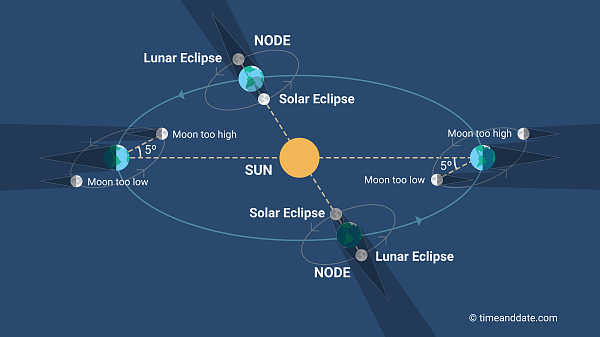What Are Solar Eclipses?
A solar eclipse is a spectacular astronomical event. Each one is only visible from a limited area.

Next Total Solar Eclipse: Mon, 8 Apr 2024 … See animation


Solar eclipses can have a maximum point that is either partial, annular, or total.
@timeanddate.com
LIVE: April 8, 2024: Total Solar Eclipse
The 7 best places to see the 2024 total solar eclipse
The Moon Eclipses the Sun
An eclipse of the Sun happens when the New Moon moves between the Sun and Earth, blocking out the Sun's rays and casting a shadow on parts of Earth.
The Moon's shadow is not big enough to engulf the entire planet, so the shadow is always limited to a certain area (see map illustrations below). This area changes during the course of the eclipse because the Moon and Earth are in constant motion: Earth continuously rotates around its axis while it orbits the Sun, and the Moon orbits Earth. This is why solar eclipses seem to travel from one place to another.
Which cities get the most eclipses?
Types of Solar Eclipses
There are 4 different types of solar eclipses. How much of the Sun's disk is eclipsed, the eclipse magnitude, depends on which part of the Moon's shadow falls on Earth.
- Partial solar eclipses occur when the Moon only partially obscures the Sun's disk and casts only its penumbra on Earth.
- Annular solar eclipses take place when the Moon's disk is not big enough to cover the entire disk of the Sun, and the Sun's outer edges remain visible to form a ring of fire in the sky. An annular eclipse of the Sun takes place when the Moon is near apogee, and the Moon's antumbra falls on Earth.
- Total solar eclipses happen when the Moon completely covers the Sun, and it can only take place when the Moon is near perigee, the point of the Moon's orbit closest to Earth. You can only see a total solar eclipse if you're in the path where the Moon casts its darkest shadow, the umbra.
- Hybrid Solar Eclipses, also known as annular-total eclipses, are the rarest type. They occur when the same eclipse changes from an annular to a total solar eclipse, and/or vice versa, along the eclipse's path.
Solar Eclipses Mainly Look Partial
Solar eclipses are only visible from within the area on Earth where the Moon's shadow falls, and the closer you are to the center of the shadow's path, the bigger the eclipse looks.
Solar eclipses are usually named for their darkest, or maximum, point. The exception is the hybrid eclipse.
The darkest point of solar eclipses is only visible from a small area. In most places and for most of the duration, total, annular, and hybrid eclipses look like a partial solar eclipse.
April 8, 2024: Can you spot the ‘devil comet’ during the total solar eclipse?
Only around New Moon
For a solar eclipse to take place, the Sun, the Moon, and Earth must be aligned in a perfect or near perfect straight line. A rough alignment of the three bodies happens every lunar month, at the New Moon.
So, why isn't there a solar eclipse every New Moon?


Lunar nodes are the locations where the Moon crosses the Earth's orbital plane.
The plane of the Moon's path around the Earth is inclined at an angle of approximately 5° to Earth's orbital plane around the Sun—the ecliptic. The points where the plane of the Moon's orbital path meets the ecliptic are called lunar nodes.
A perfect or near-perfect alignment of the Sun, the Moon, and the Earth can only take place when the New Moon is near a lunar node. This can only happen during periods that come a little less than 6 months apart, and last, on average, around 34.5 days. It is only during this time, also known as the eclipse season, that eclipses can occur.
When there is a Full Moon during the eclipse season, we see a lunar eclipse.
Protect Your Eyes!
Never look directly at the Sun, eclipsed or otherwise, without any protective eyewear. The Sun’s radiation can burn the retinas in your eyes leading to permanent damage or even blindness.
The best way to safely watch a total solar eclipse is to wear protective eclipse glasses or to project an image of the eclipsed Sun using a pinhole projector.




